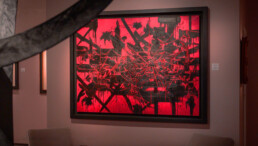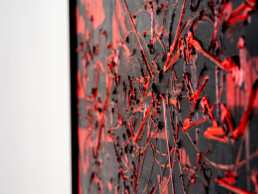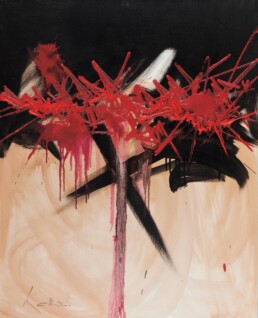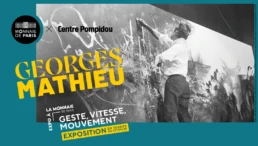Two major works by Georges Mathieu from the 1980s in the Galerie Hurtebize collection in conjunction with the “Geste, Vitesse, Mouvement” retrospective at La Monnaie de Paris
On the occasion of the current retrospective at La Monnaie de Paris, entitled Geste, Vitesse, Mouvement, Galerie Hurtebize highlights two significant paintings by Georges Mathieu from its collection: Deuil de la folie (1986) and Haine d’Orgueil (1988). These two works illustrate the major characteristics of the artist’s production in the 1980s, a period now reappraised for its expressive power. Two major works by Georges Mathieu from the 1980s in the Galerie Hurtebize collection, in resonance with the “Geste, Vitesse, Mouvement” retrospective at the Monnaie de Paris.
Deuil de la folie (1986): chromatic intensity and explosive composition
Produced in 1986, Deuil de la Folie (Mourning for Madness) bears witness to Georges Mathieu‘s plastic evolution in his late period. The work is distinguished by the use of a uniform, saturated red background, onto which a network of black and red projections is inscribed in the center of the composition. The visual impact is based on a strong chromatic contrast and a tight organization, with lines converging on a structuring core.
Here, Mathieu retains his historic working method: he paints standing up, without prior sketching, applying the paint directly from the tube. This rapid execution protocol, which he developed as early as the 1950s, reflects his commitment to an immediate, unrepentant gesture.
His composition is based on a powerful tension between color and gesture. The title, Deuil de la Folie, suggests a strong emotional charge. This work perfectly embodies the explosive plasticity that characterizes Mathieu’s work of the 1980s.
Haine d'Orgueil (1988): gestural explosion and structural tension
Two years later, in 1988, Mathieu produced Haine d’Orgueil (Hate of Pride), a work that continues this explosive aesthetic. The canvas’s light background highlights red and black projections applied directly with acrylic paint, in a composition that is more open, but just as dynamic.
The treatment remains faithful to the artist’s fundamental principles: absence of preparation, single gesture, rapid execution. This work reflects Mathieu‘s mature interest in dense compositions, while retaining a plastic vocabulary consistent with his earlier periods.
The visual force of Haine d’Orgueil testifies to the artist’s desire to push his pictorial language further, while asserting a free expression independent of the dominant currents of the time.
Two works echo the “Geste, Vitesse, Mouvement” retrospective at La Monnaie de Paris
The presence of these two works in the Galerie Hurtebize collection is in keeping with the reappraisal of Georges Mathieu‘s last period of production. The “Geste, Vitesse, Mouvement” exhibition at La Monnaie de Paris devotes significant space to this sequence, long perceived as secondary, and now recognized for its coherence, visual power and fidelity to the original spirit of lyrical abstraction.
By exhibiting Deuil de la Folie and Haine d’Orgueil, Galerie Hurtebize enables the public and collectors to explore a decisive period in Georges Mathieu’s career, known as the cosmic period, and now reassessed.Two works echo the “Geste, Vitesse, Mouvement” retrospective at La Monnaie de Paris.
The “cosmic period”: renewed lyrical abstraction
The works Deuil de la Folie (1986) and Haine d’Orgueil (1988) belong to what is known as Georges Mathieu‘s cosmic period, extending from 1983 to 1991. This phase is well identified and widely recognized in France, Italy and Asia, not least for its affinities with Far Eastern calligraphy.
After geometric experiments and forays into the applied arts in the 1960s-70s, Mathieu made a radical return to gesture in the 1980s. His paintings from this period are characterized by broken lines, explosions of paint, controlled drips and high-contrast backgrounds. This turning point, described in turn as barbaric or galactic, profoundly renewed his plastic vocabulary, while reaffirming his rejection of geometry.
It was also during this period that Mathieu returned to the lyricism of the ’50s with a new, more explosive and contrasting approach.The “cosmic period”: renewed lyrical abstraction.
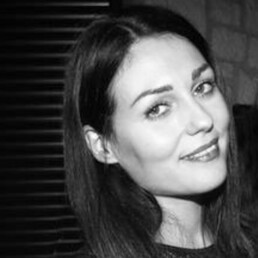
Celine Fernandez
With 15 years' experience in marketing and communications, Céline has worked for major companies such as Hopscotch, Groupe Galerie Lafayette and several communications agencies. For more than 4 years, she has been managing the gallery's communications through the website, social networks and traditional media.


